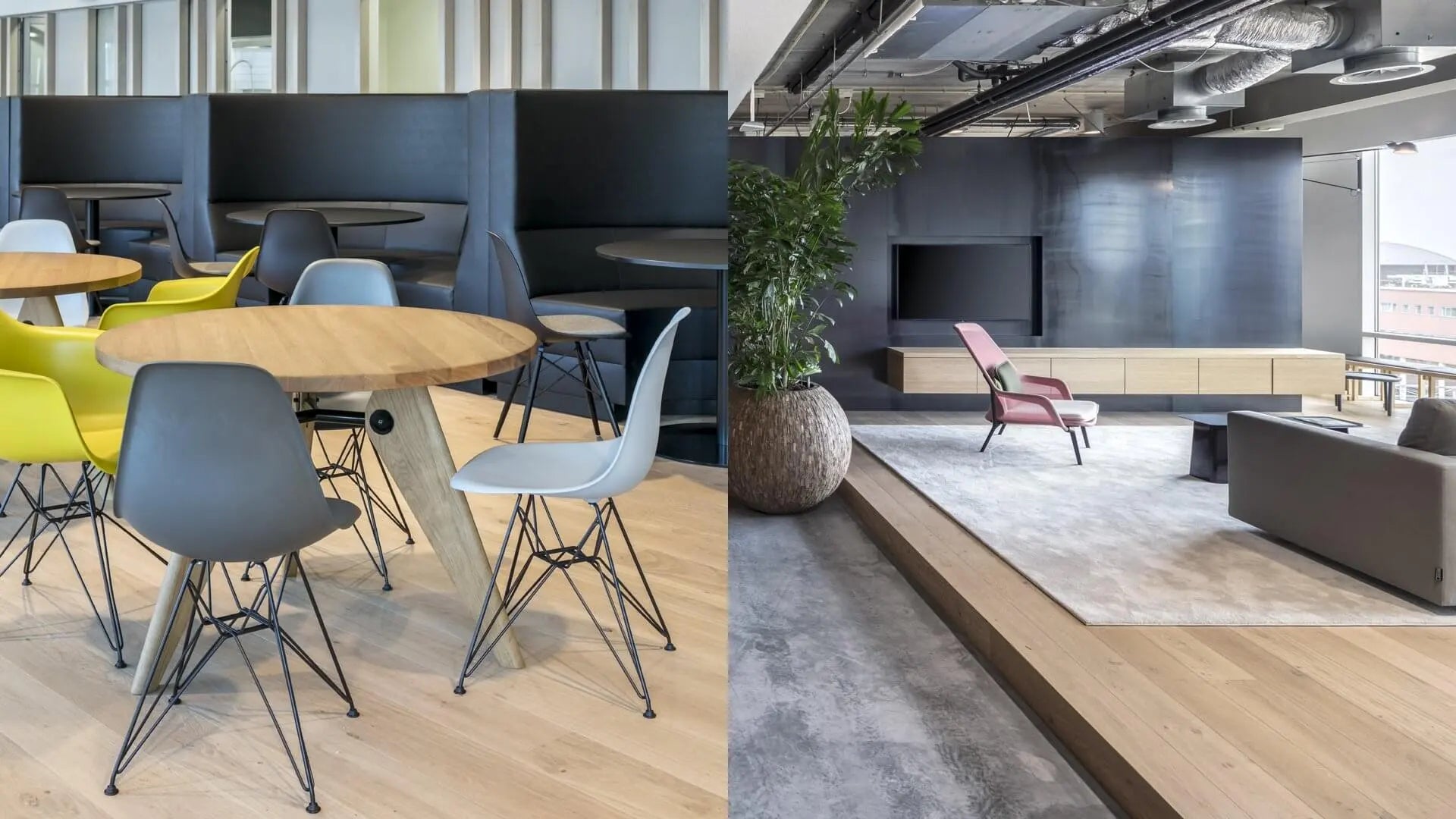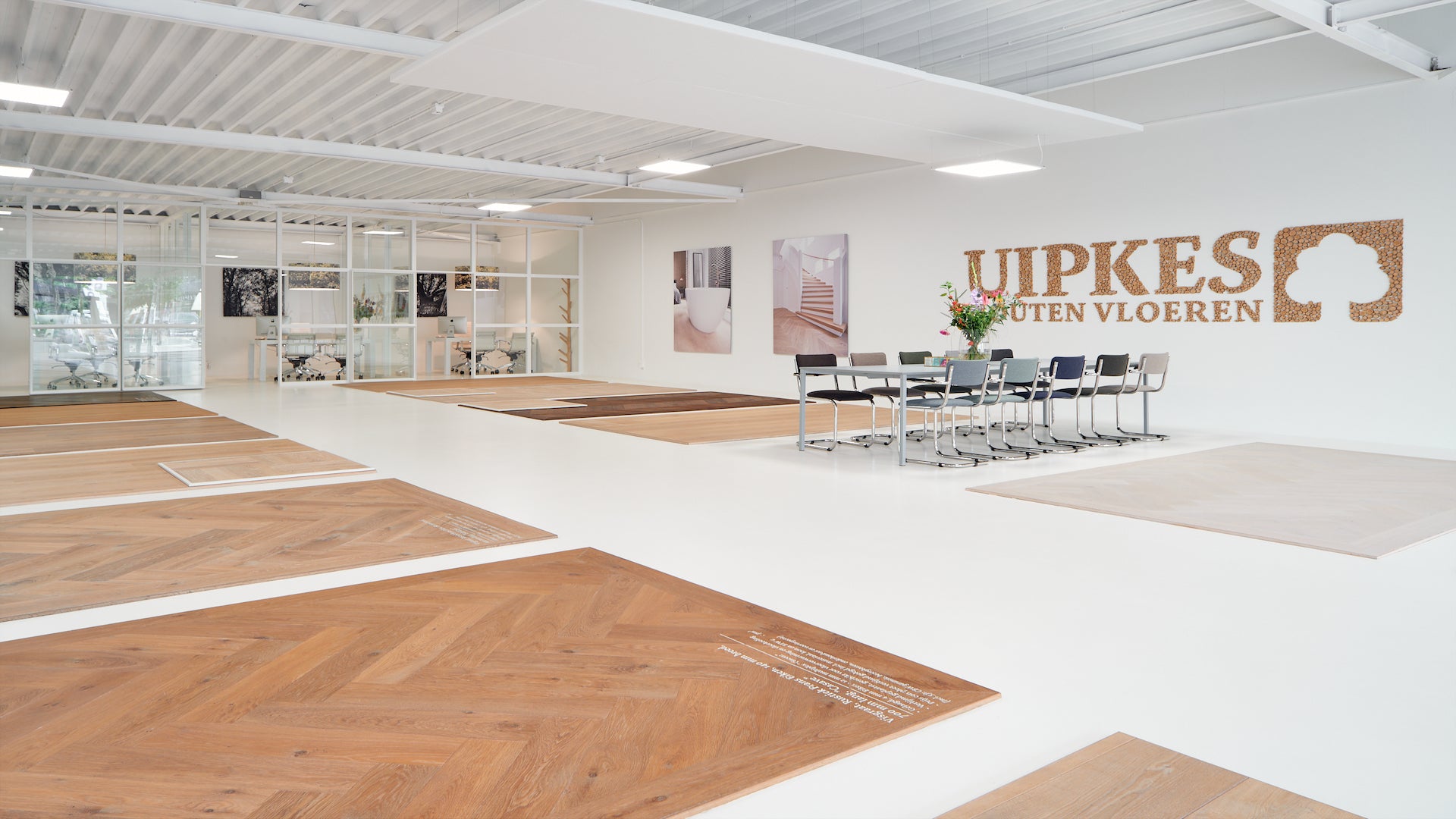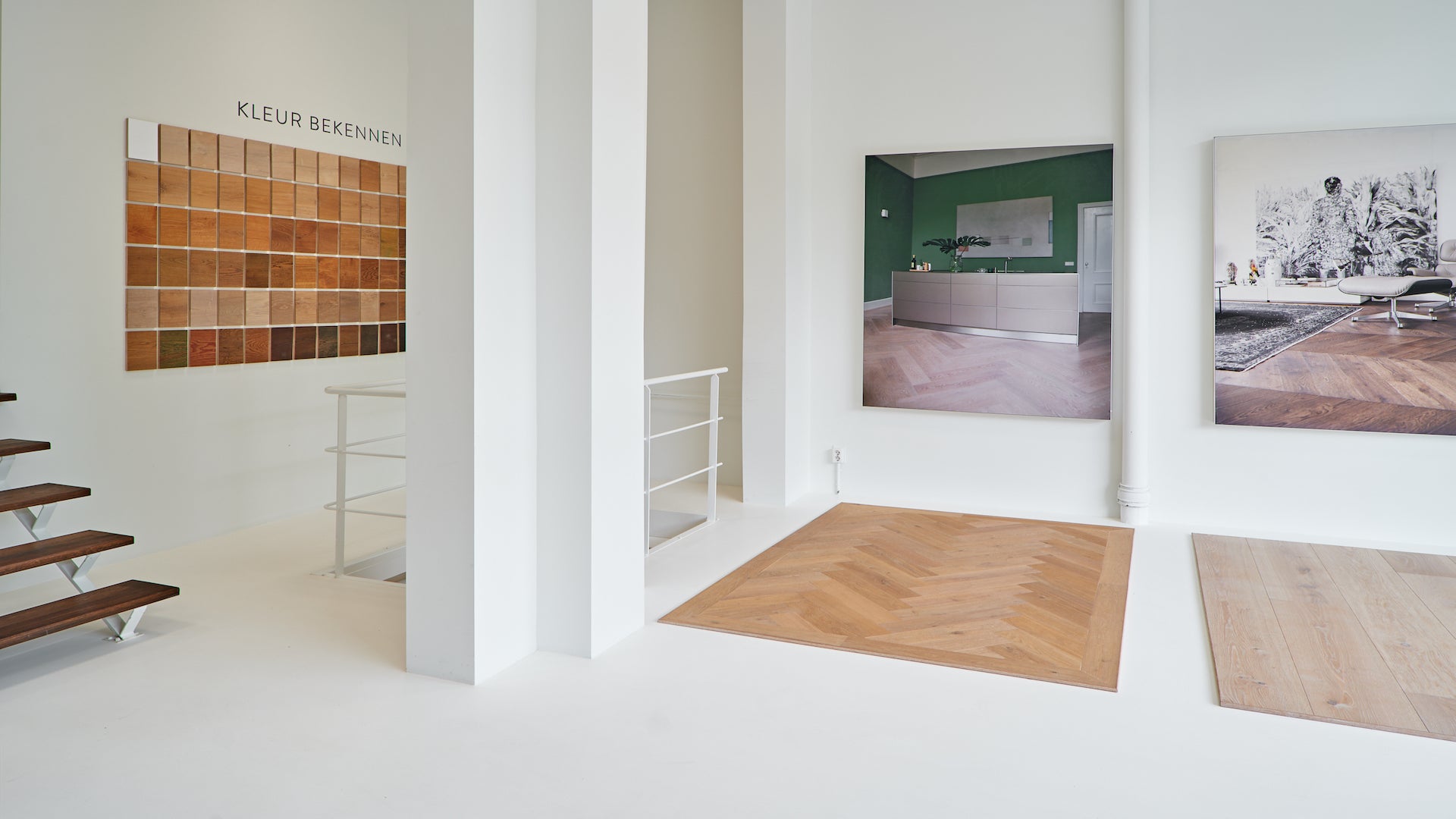Veelgestelde vragen

Here we present the answers to frequently asked questions about wooden floorsthat we often receive in our showrooms. Is your question not listed here or would you like to know more? Email us at info@uipkes.nlor call 0172-477355.
Vragen? Kom langs voor advies!
Frequently Asked Questions
Can a wooden floor be installed over underfloor heating ?
Yes, we can and have been doing this for years. It is possible to install lamel parquet (layered planks) on underfloor heating. It is important that the heating protocol (this is a fairly simple operation) is carried out once, so that the work floor and later the parquet floor are gradually heated.
Layered planks can also be glued directly onto the work floor if it is sufficiently flat. Or floating on special underfloor heating foil called alu-heat. Using Underfloor heating as 'main heating' under a solid wooden floor is not recommended. Wood insulates and shrinks due to the high temperature. The expansion and contraction of a layered plank is limited and depends on the relative humidity.
Can a wooden floor be delivered in any desired color?
The floors are made in the color you want. We have dozens of different colors in our range. If we do not have the color you want, we will be happy to custom make it for you. This is something we have been doing for more than 15 years, so don't hesitate to ask us. Finishing with oil ensures that the wood structure is more prominent and the floor gets a warm, natural look. Oak floors can also be smoked (dark discoloration) or colored with pigmented oil from chalk white to dark brown. This gives your oak floor a unique character.
Is it also possible to install the wooden floor in my kitchen?
The floorboards and finishing products are so strong that a wooden floor can also be installed in the kitchen . You can spill all types of moisture on the floor without causing damage to the wood, but you do have to clean up the moisture.
Because the kitchen is a room that experiences relatively more wear and tear (for example, the countertop), it is important to know that in many cases the floor in the kitchen will require more maintenance.
Can a wooden floor be supplied in any desired width?
Our wooden floors are available up to 38 cm wide, so for example we can supply 22, 24, 26, 28 or 30 cm wide engineered wooden planks. We also make the pattern, so planks, herringbone or chevron floors in all kinds of sizes and colors as you want. This creates dozens of variations of beautiful wooden floors.
Why is there a price difference between suppliers?
Unfortunately, wooden floors are made that are offered cheaply, but are of poor quality. In addition, there are suppliers, including Uipkes, who supply wooden floors that are literally and figuratively sustainable. Products that are made in the Netherlands the way you would like them.
Wooden floors that have the properties to enjoy for years to come. A wooden floor from Uipkes is a wooden floor for life. Read more information about what the costs are for a wooden floor per m2 and how the price is determined.
Do I get a warranty on the wooden floor and installation?
Uipkes Wood Flooring is a recognized CBW member and gives a 5-year warranty on the wooden floors and installation. Uipkes does not require a down payment when you buy a floor , so you only pay at the time of delivery.
Can I view a sample wooden floorboard at home without obligation?
We have wood samples of most wooden floors. We will send these by post or you will receive them for free when you visit the showroom. We also have various sample boards of 60 x 120 cm to give so that you can check at home on different days and at different times of the day whether you have the right floor in mind. Please call 0172-477355 to make sure we have the correct sample board.
What is the thickness of a solid wooden floor?
The thickness of the solid wooden floor parts is 20 mm. The thickness of the subfloor is 14 mm. The total floor therefore has a thickness of 34 mm. Pay attention to this, for example, when installing a new kitchen, moving or renovating. Have the installer raise the kitchen by 3.5 cm to prevent back problems in the long term.
What is the thickness of the layered planks?
We supply layered planks with a top layer of 3 mm wood, total thickness 10 mm (Floortje), 4 mm wood, total thickness of the plank 16 mm (Vincent) and layered planks with a top layer of 6 mm, total thickness of the plank 20 mm. (Robin). When the floor is glued, the thickness of the glue is neglected. The subfloor adds approximately 3 mm in height when it is placed on foil.
What is the length of the floorboards?
The length of the solid floorboards varies between 150 cm and 250 cm. The length depends on the wood specie . Shorter parts can be incorporated into the floor. These can be used to complete or start a 'row'. When installing, we recommend placing the floor in a so-called 'staggered pattern'. This means an offset of +/- 40 cm each time. The width of the floorboards varies between 10 and 38 cm (depending on the wood specie ).
What is a beveled edge?
A beveled edge or V-seam is a sloping edge on the long side of the plank at an angle of 45°. This bevelled edge ensures that planks are accentuated, creating a real wooden floor. It is also possible to supply a floor without a bevelled edge. This creates a floor that is 'smooth' over the entire surface.
What is the delivery time of the wooden floors?
If you want us to take care of the installation, the delivery time is approximately 3 to 8 weeks. Please check with Uipkes so that we can choose the right time of delivery and installation together, info@uipkes.nl or call 0172-477355.
The installation and delivery date can be changed up to 4 weeks before the agreed date. Transport costs at Uipkes Wood Flooring are included for complete floors from 30 m² and we deliver throughout the Netherlands (excluding the Wadden Islands). We mainly supply oak floors , but we can supply a number of other wood species on request. Ask us about the delivery time.
Is it possible to install the floor yourself?
This is certainly possible with the help of our diy installation instructions. Here you will find all the facets that play a role in installing a floor. If the floor is installed according to these instructions, you will receive a three-year warranty according to the CBW -conditions. Even if you want to install the floor yourself, we will inspect your work floor.
How is the floor installed?
Layered floors such as Vincent, Floor or Robin are generally isntalled directly glued to a pre-treated subfloor . This makes the floors suitable for underfloor heating .
Layered wooden floors can also be installed floating on a foil subfloor if desired to achieve an 11 dB noise-reducing subfloor.
The wooden floor can be installed in different ways. In general, the terms floating on slats, floating on foil , floating on alu-heat ( underfloor heating foil), glued on chipboard and glued directly on the work floor are used for these installation methods .
With a floating floor on slats, a vapor barrier foil is first placed on the existing work floor, whereby the seams are sealed with aluminum tape. Spruce wooden planks are then placed over the foil, perpendicular to the length of the floorboards. The space between the slats is filled with sound-absorbing material to prevent the 'sound box effect'. When the subfloor has been installed, the solid parts in the 'knife' of the plank are blindly nailed to the underlying rafter at an angle of 45° with a staple. The floor can then be finished.
When installing glued on a sand-cement floor, an underlay of chipboard is first glued to the sand-cement floor . Is the workplace floor made of a material other than sand-cement, or too wet? The floor is then first treated with a primer. It is also possible to install a glued floor on a wooden subfloor. A layer of rubberoid is first placed on the wooden work floor. Chipboards measuring 125 cm x 82.5 cm are then used and screwed to the wooden work floor.
Which installation method is better?
Both floating and glued installation is possible in both small and large spaces. A floating floor is experienced as a real wooden floor, while a glued floor has a much more massive sound. A floating floor offers sufficient noise reduction (11 dB), which is why this installation method is often used in apartments.
Can I choose a wooden floor in my apartment?
You increasingly see that people take a floating construction floor into account during construction, so that a wooden floor can be installed directly on the construction floor without having to install it 'floating' again.
However, it may happen that hard floor coverings have not been taken into account during construction. When installing a wooden floor in apartments you are bound by the noise standards that have been established by the Owners' Association (VvE) or by the housing cooperative.
For this reason, wooden floors in apartments are always installed floating. By using a floating floor, a reduction in impact noise of 11 dB is achieved. If desired, you can also use an underlay here that reduces 21 dB.
How long does it take to install a wooden floor?
Naturally, this depends on the surface of the floor, the layout of your home and additional work to be carried out, such as shortening doors or installing solid skirting boards. We will carry out a preliminary inspection a few weeks in advance and can then view the areas to be installed and indicate approximately how long the work will take. When installing ready-treated floors, you can expect approximately one day less time.
How often should I maintain my floor?
In order to enjoy yourwooden floors for as long as possible, it is advisable to regularly dust or vacuum it and clean it with the items you find in the maintenance set that you receive from us when you buy a floor from us. When you perform the correctmaintenance, you extend the lifespan of the finishing layer.
Especially after the first month, it is important that the floor is provided with the supplied maintenance product. If you have an oiled floor, you can vacuum the floor and then wipe it with a damp mop with Clien-Z mixed in the water. You can also maintain the oil layer by regularly applying a layer of maintenance oil to the floor in heavily stressed areas.
Can the floor still expand or contract?
Wooden floorboards are produced from dried wood. This means the floor retains its quality in the Dutch climate. Due to fluctuations in the humidity percentage in summer and winter, the floorboards can shrink and expand. > due to fluid loss and fluid absorption.
When the humidity percentage drops below 40%, you must humidify the air using a humidifier to limit the 'deformation' of the floorboards. You can measure the humidity percentage using a hygrometer that we will give you as a gift when we come and install the floor. If the humidity percentage is kept at or above 40%, the floor will hardly have a chance to shrink.
Can a wooden floor be placed on a tiled work floor?
If you have tiles as a surface, you can – with the right preparation – install a wooden floor. The size of the joint and the type of tile that serves as a base are important. With a tile with a smooth surface and small joints, it is possible to install both a floating and a glued floor.
When the floor is glued, the work floor must first be thoroughly cleaned with ammonia and clean water. It is then necessary to pre-treat the tiled floor with a primer.
We do not have a sand-cement floor, but a wooden work floor. Can I choose a solid wooden floor?
It is also possible to have a solid wooden floor installed. You can choose to install the floor floating or glue it. When gluing, instead of gluing chipboard, the chipboard is screwed to the existing wooden floor.
Can a wooden floor be installed in my bathroom?
In general you can! For more information, see our specific application page about a wooden floor in the bathroom.
When can I have the floor installed in my kitchen?
Installing the kitchen depends on the version. Does your kitchen have a front plinth? Then install the kitchen before the floor is instaled. When installing, have the kitchen mounted at your desired 'working height' plus the thickness of the wooden floor including subfloor (35 mm applies to solid floorboards, for layered planks this varies between 18 and 23 mm).
If you fail to do this, you will be standing higher than the countertop, which can lead to back problems, for example. After the floor has been placed, the kitchen technician can replace the front skirting boards. Installing the kitchen earlier also has the advantage that you do not run the risk of damage to the new floor during installation of the kitchen.
If you have a kitchen on legs so that you can see under the kitchen or with continuous sides up to the top of the floor, this must be installed after the floor has been installed.
Please note the minimum drying time of the applied oil of 48 hours (this does not apply to pre-treated floor parts). It is wiser, if possible, to only install the kitchen after 14 days due to the hardening time of the oil.
In addition, the floor should not be covered for the first two weeks after installation because it must be able to 'breathe'. It is of course advisable to instruct the kitchen technicians to be careful when sliding kitchen cabinets, for example, and to wear work shoes. Make clear agreements about this with your kitchen supplier.
Is it possible to change an existing wax or lacquer floor into a floor finished with oil?
It is certainly possible to change a wooden floor that has been finished with a wax layer into a floor that has been finished with oil. Make sure the space is empty. Sand the entire floor, including the beveled edges and remove the existing cover strips. Then finish the floor with oil.
What are the costs for resanding and finishing my floor?
The average costs for sanding and finishing of an existing floor amounts to ± € 30.00 to € 35.00 per m², excluding oil, abrasives, call-out costs, extra installation costs (for example after a renovation) and cover strips.
Can I move my solid wooden floor with me?
A wooden floor cannot really be moved. With both a floating and a glued floor, the floor parts are blindly nailed in the knife and with staples on the pine wood beams or chipboard subfloor respectively. When removing the floor, the existing staple will destroy the tongue and groove.
However, there is one option to move the removed floor with you. The remaining floorboards must then be 'planed back'. This back planing ensures that the floorboards become 2 mm thinner and 2 cm narrower. This makes the actual efficiency 60% of the existing floor space. We can then refine the remaining surface to size.
Does plastering a wall affect the floor moisture percentage?
The influence of spachtelputz on the air moisture percentage is nil. Plasterwork consisting of a plaster product uses an enormous amount of water and a lot of moisture will be released during the drying of a plastered wall, resulting in a temporary increase in the relative moisture percentage. With normal ventilation and when using, for example, the existing heating, this moisture disappears within approximately seven days.
Can I opt for a wooden floor in my new-build home?
Yes, it is a misunderstanding thatnew-build homes are always too damp. On average, new-build homes are wind and watertight 3 months before the actual delivery date. Due to the natural ventilation in these new-build homes, the floors are rarely too wet for installing a solid wooden floor.
During our preliminary inspection we check, among other things, the moisture percentage of the subfloor. If the floor is too damp, it may be possible to dry the room mechanically. If the floor is still too damp because the screed was poured too close to delivery, it is better to wait a few weeks before installing the wooden floor parts. If this is not possible, the floor can be provided with a moisture barrier.
What does smoking a floor entail?
Oak is a wood specie that can easily be 'smoked'. This smoking is done using ammonia. Containers containing ammonia are placed in the room where the floor is to be installed. The ammonia fumes react with the tannic acids in the oak wood.
This chemical reaction removes the tannic acid from the planks, darkening the natural color and making the grain pattern more visible. The smoking process can vary from 2 hours to 8 hours (depending on the desired coloration).
The degree of discoloration depends on the percentage of tannic acid present in the wooden floor parts. After the floor has been smoked, the floor can be finished with oil (possibly with color pigment). Always ensure that the floor is properly sanded and dust-free before you start using finishing or maintenance products.
Showrooms
- Choosing a selection results in a full page refresh.
- Opens in a new window.

